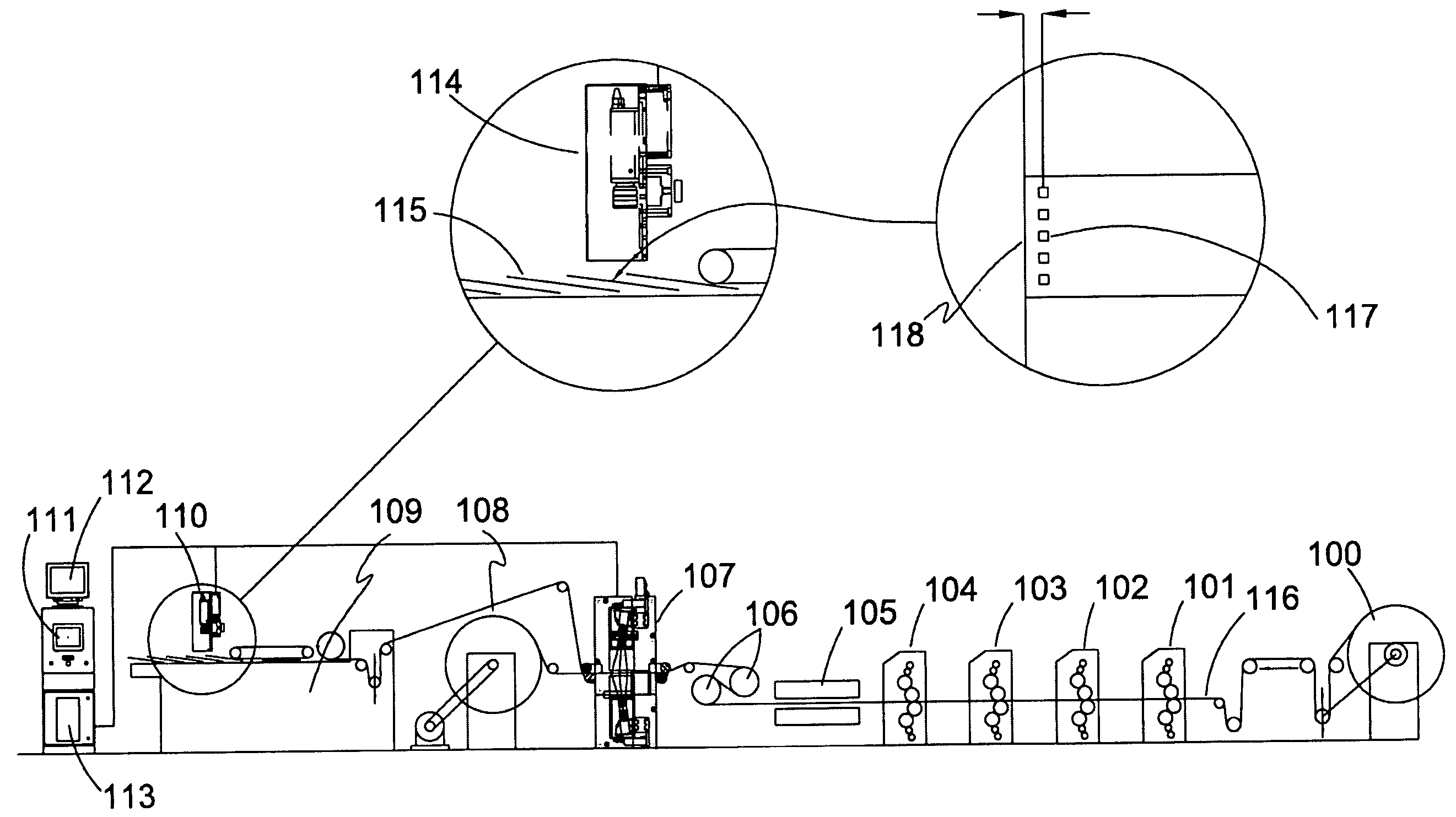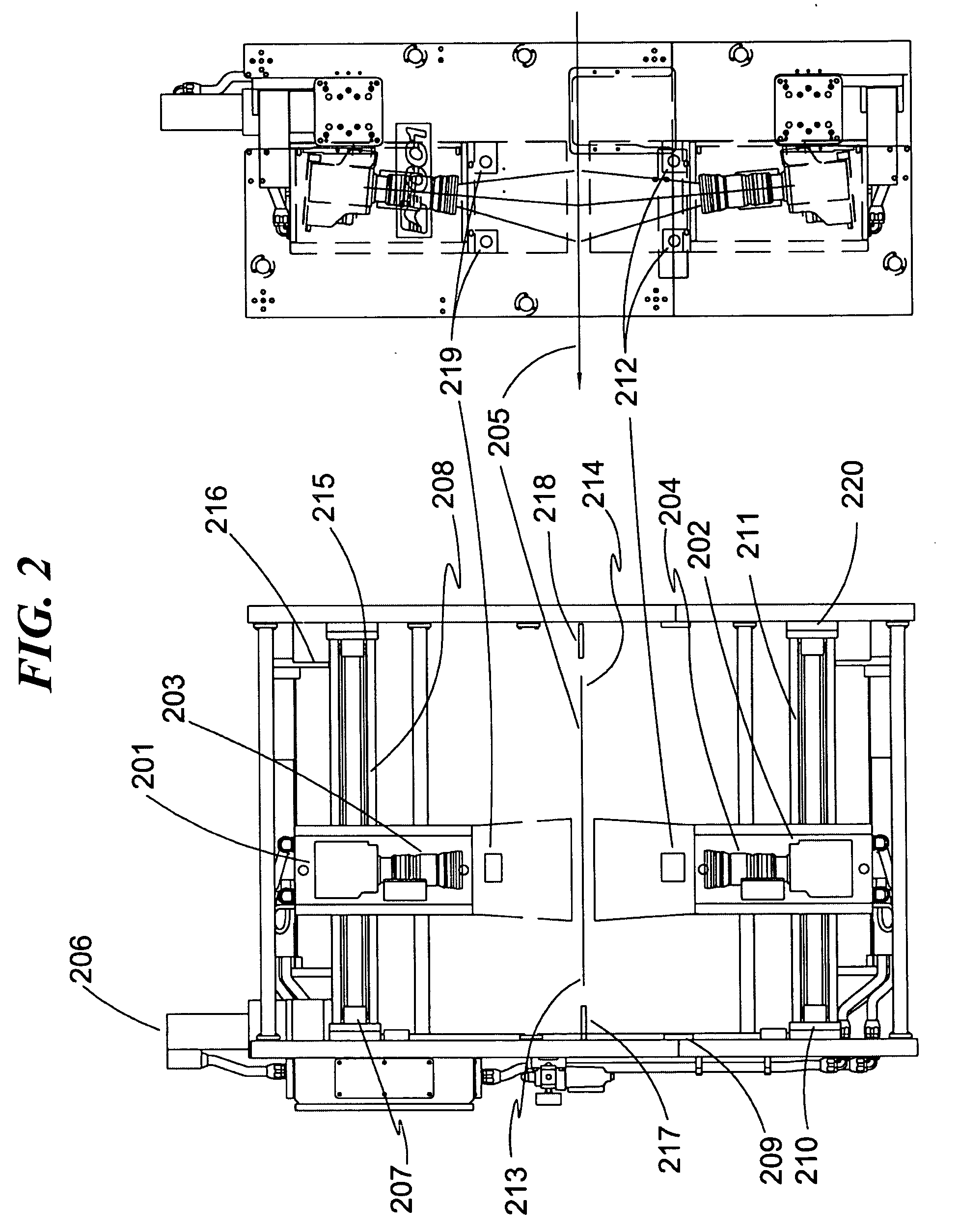While the distance method described in the U.S. Pat. No. 4,482,972 patent deals with rotational
distance measurement, no attempt is made to provide support for both length and width measurements, nor is there any support for incorporating
wide field of view or multifunction web inspection / control functions.
These systems tend to be rather crude in their register control, as the sensitivity and accuracy of the systems depends on the use of a photocell as the
detector element.
Additionally, multiple spatially disparate registration marks require the use of separate
detector systems, requiring a multiplication in hardware expense as well as consideration of mechanical drift issues as the web manufacturing equipment wears with time.
Specifically, while the ink
deposition rate is controlled with the teaching of this patent, there is no method to perform accurage register control, an important and costly aspect of any manual printing process.
This system operates on stationary materials, a significant constraint when compared with moving web manufacturing processes.
Registration marks in the context of the U.S. Pat. No. 3,988,535 patent are essentially fixed in time and space, whereas in moving web printing the targets move and there is a significant issue of repeatable registration which must be addressed that is not present in beam-lead
chip bonding.
Additionally, the strobe method may allow calculation of travel distance for individual particles, but provides no method of determining the proper registration of a web printing process.
Furthermore, the use of a
microscope in a production web printing application would be inappropriate, as the required
field of view would require significant movement of the
microscope by precision mechanical
stepper motors, or alternatively, a multiple number of fixed microscopes.
While this patent discloses the combination of multiple images into a single
video image, it does not disclose any method by which the camera positions may be moved or calibrated across moving web material.
This patent does describe a method by which individual bars may be realigned, but fails to incorporate any method by which the relative distances between the bars may be accurately calculated.
Thus, the use of stereoscopic inspection techniques is limited to instances in which a "good" product may be relatively easily generated.
The technology surrounding this patent deals primarily with synchronization of the camera to the web material with the use of a strobe system, and has no method of providing for
distance measurement or the use of a movable
zoom camera system.
This has a significant time and
cost savings for manufacturing, as the generating of an acceptable comparison web sample can take time and
waste material.
However, there is nothing in the Gnuchtel patent that describes methods or apparatus by which one may calibrate the position of the image sensors or provide a method of determining the relative positioning error in the camera location.
The Gnuchtel patent also fails to allow the use of
wide field of view lenses or
Zoom Lenses to provide the ability to locate web registration marks over a
wide field of view.
The Gnuchtel patent essentially brings new technology to the Wales patent but goes no further in improving the overall accuracy of the camera positioning techniques disclosed by Wales.
Note, however, that Sainio only claims the use of photo-optical line
scanner sensors (using a
tungsten-
halogen lamp as the illumination source) and does not make use of any
Zoom Lens technology to obtain wide field registration or provide any method of overcoming the need for multiple cameras to perform wide-field registration operations.
Sainio's method and disclosure are limited to sensor arrays which are positioned perpendicular to the direction of web travel, meaning that the method described can only be used when the press is operating.
However, the fact that Sainio's method does not permit a wide
field of view with accurate distancing restricts the use of this apparatus to low-resolution registration applications.
A significant issue in this type of sensing apparatus is that of press web
jitter.
This
jitter makes sensing as described in the Sainio patent troublesome, as it becomes difficult to accurately determine the exact relative position of the registration mark center because of this inconsistency in web velocity.
As mentioned previously, Sainio used
a diamond-shaped registration mark to help offset this problem, but this approach is insufficient to correct the problem of web
jitter over the range of permissible web manufacturing processes.
No prior art system claims to permit this type of registration using the final product itself as the registration mark.
Of significant note in the Brunetti patent is the lack of any support for wide-field Zoom Lenses which permit the location of widely disparate registration marks.
Furthermore, Brunetti neither claims nor discloses any method to calibrate the accurate position of a camera or
image capture device in respect to the web material registration marks.
No method is provided to compensate for
mechanical wear in the system as well as permit compensation for registration drift across a wide width web.
This would not be possible with the Brunetti teaching, as it discloses no method by which wide-field variations may be captured, nor is there any camera distance calibration method to permit accurate distance measurements across the web width.
While the use of an integrated row of image sensors is an advancement in technology as applied to web registration control, it suffers from the same drawbacks as other conventional camera /
microscope single-lens systems, or systems with a single
mobile camera.
The problem of accurate camera positioning with respect to the web medium is still an issue and one that is not fully addressed by any of these approaches.
Additionally, the Monney disclosure lacks the capability of a wide
field of view, requires that the press be moving to operate effectively, and suffers from the same press jitter problems as the Sainio invention.
As stated previously, this does produce a limitation on the width range with which these systems may operate.
Typically, the wider field of width inspection required, the higher the cost of these systems.
This restriction is too limiting for many printing operations, especially those who have many customers or customers with stringent
quality control requirements that dictate full-width inspections of manufactured web material.
If, however, only one or two of the functions are required, the cost of the complete system can be considerably more than the cost of one or two separate systems.
Additional cost is incurred in the more expensive ink and costs in disposing of the
waste material as land fill instead of recycling.
Additionally, high accuracy color register requirements has greatly increased waste material attributable to job
changeover transitions in which initial color register must be performed, and during register transient conditions such as occur during web splices, and at each start-stop.
However, the combination of this technology with distance calibration over the width of the printed web is new to the art.
While several patents, such as the Wales U.S. Pat. No. 4,736,680 and Gnuechtel U.S. Pat. No. 4,794,453 disclosure, describe a
traverse mechanism on which the register mark scanning device is mounted, these implementations are necessarily semi-manually controlled because of the lack of accurate traversal distance calibration inherent in these systems.
None of these systems have web inspection capability as they are register control devices only and dedicated solely to this function.
Note that the narrow field of view in both these implementations (inherent in any fixed
magnification lens system) restricts the ability of the system to compensate for lateral web shift as the press heats up or the web material shifts during manufacture.
Thus, the manual positioning aspect of these systems means that it is impossible for the web printing system to be
fully automated or controlled remotely.
Additionally, the use of fixed lens systems means that any distance measurements obtained by the Wales and Gnuechtel systems is inherently a relative
distance measurement, and not an absolute distance, since there can be no calibration standard by which to compared the measurement on a two dimensional web surface, since in most cases printing on the web surface is subject to thermal and mechanical forces that are not predictable.
A significant
disadvantage of the Wales / Gnuechtel systems and their counterparts is an inability to obtain automated absolute distance measurements from a given printed web reference and the edge of the web.
This lateral alignment problem is a very common web press setup issue, and as such there is great economic incentive to automate it without the need for constant human intervention.
The Wales / Gnuechtel technologies are inadequate to solve this common problem in the art.
Additionally, while a variety of web inspection / control functions have been documented in the prior art, there is no single system that discloses or claims an apparatus or procedure for integrating all of these functions into a single hardware /
software system.
The field of view limitations and lack of distance calibration in the prior art relegates all of these systems to single-use applications.
As a result, the overall system cost to implement a variety of web inspection / control functions increases linearly with the number of
web image inspection (
image capture) sites and web inspection / control functions to be implemented.
 Login to View More
Login to View More  Login to View More
Login to View More 


